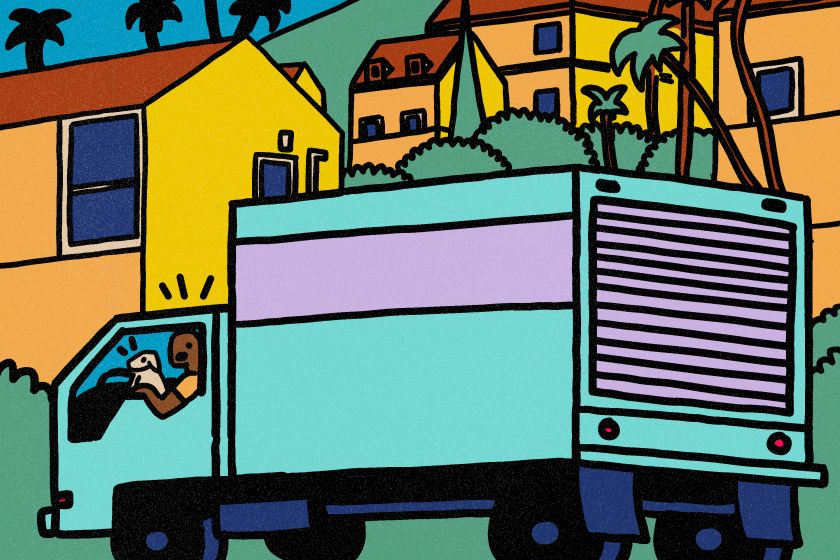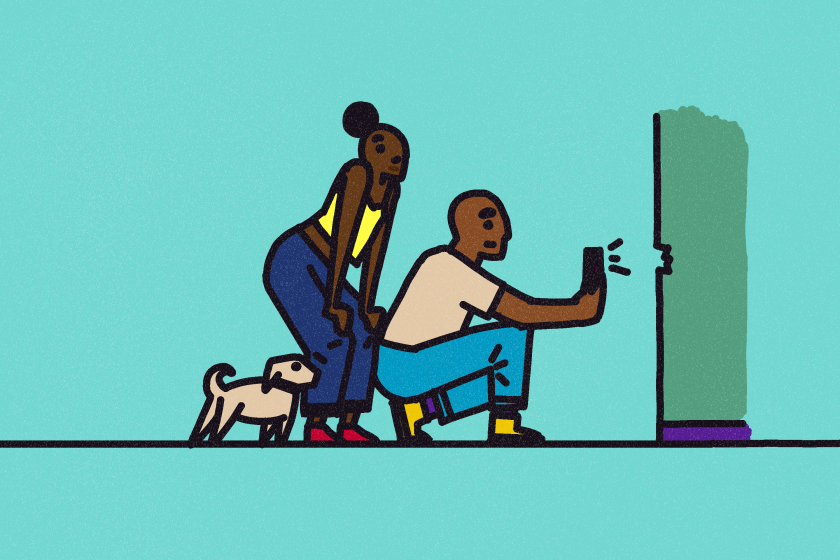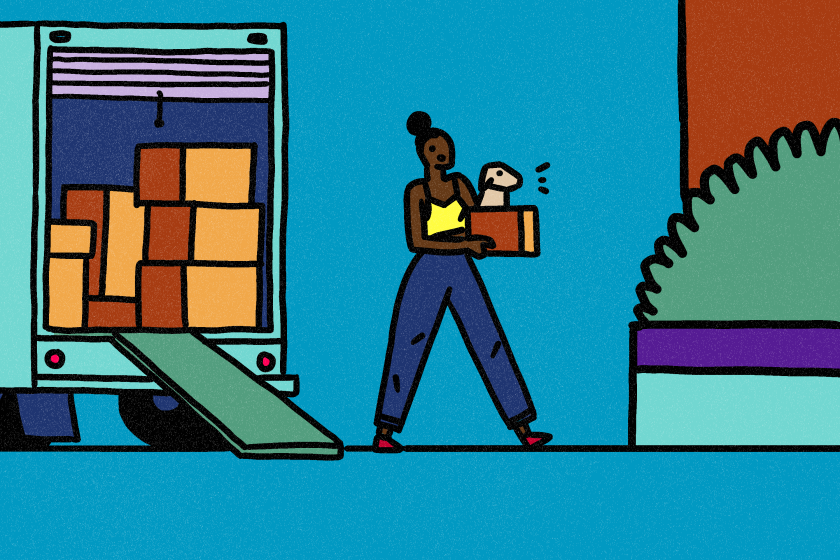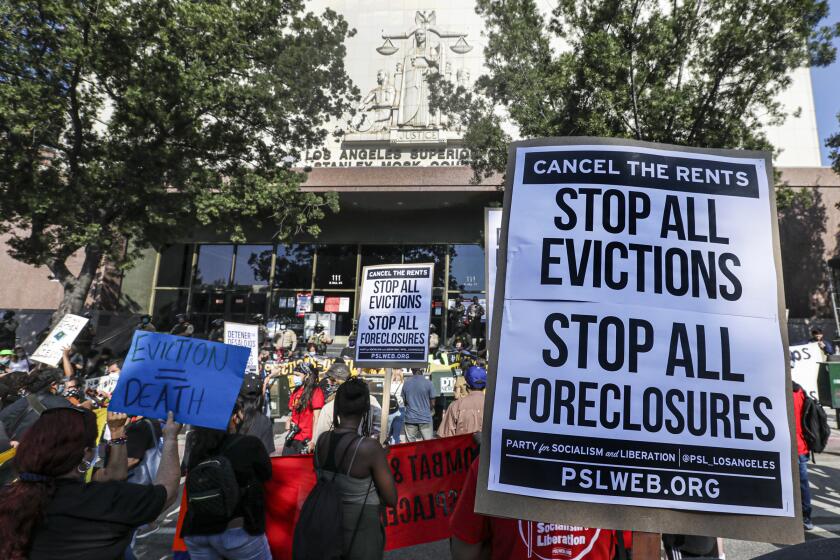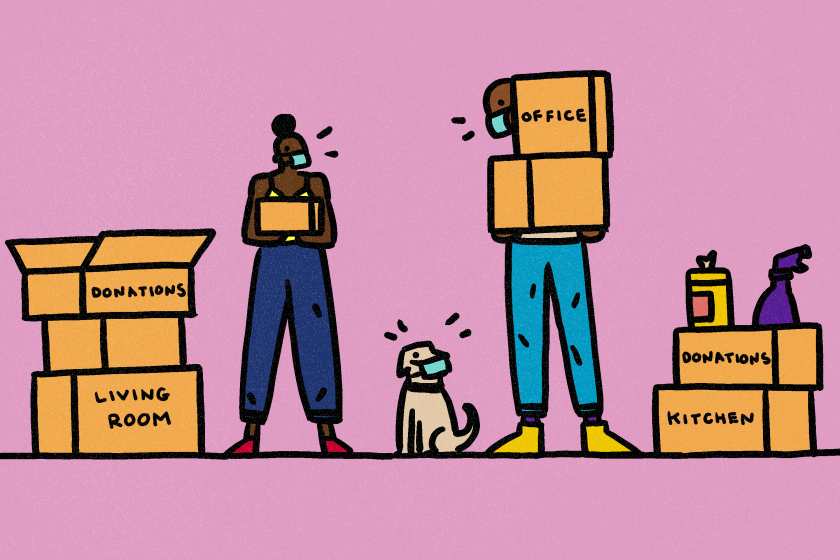Here’s how to move in and move out efficiently and with as little stress as possible
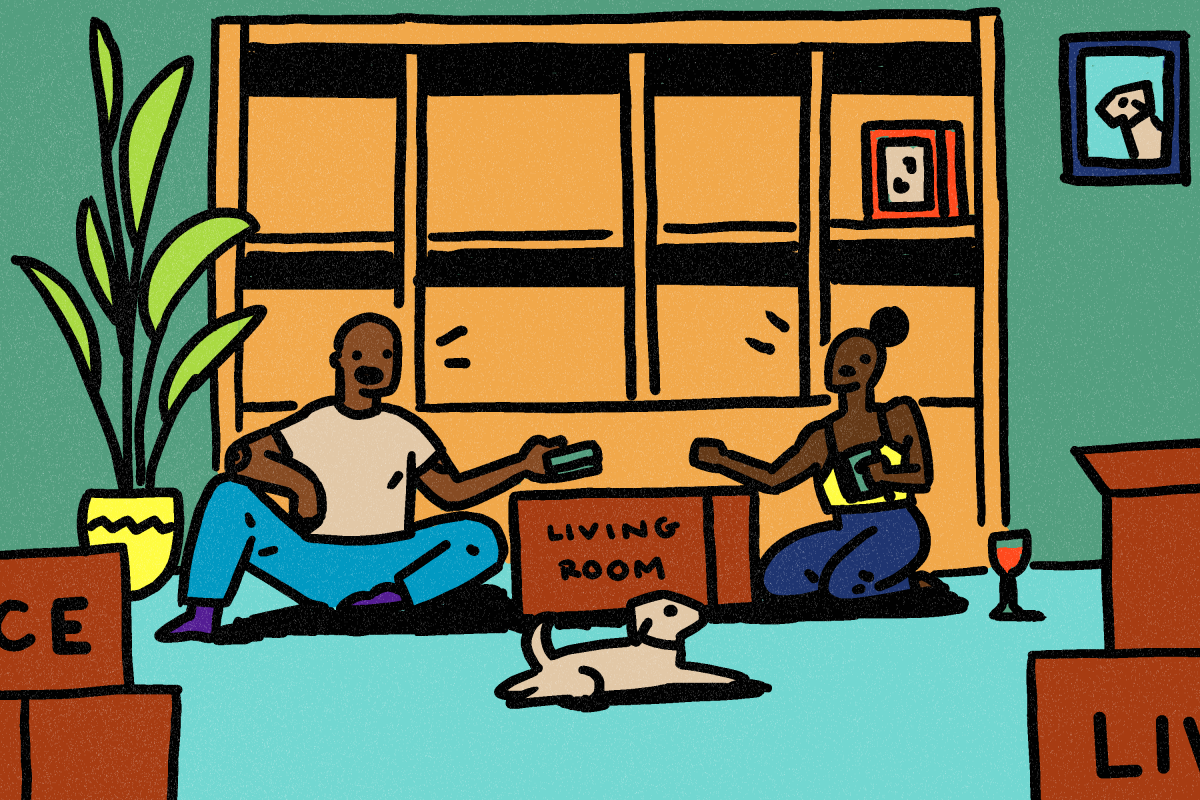
- Share via
“A move is like a wedding,” said Lori Gersh, a professional organizer who specializes in moving services. “The more you plan it, and the more you have everything figured out ahead of time, the easier it’s going to be.”
Instead of figuring out the flowers, the clothes, the music and the food, moving means you need to turn on and off the utilities, change your mail, decide where each piece of furniture goes in the new place — and everything else on your personalized checklist.
For the record:
3:35 p.m. Nov. 19, 2020This article incorrectly says that basic moving insurance often covers only 60 cents per pound for damaged items. In fact, that rate is not insurance but is what moving companies are usually liable for, under federal and state regulations, if the customer does not pay for extra protection or a third-party insurance policy.
“If you can do all your decision making when you’re not under pressure, you can think it through,” she said. “Whereas if you have to make all these decisions at once on move day, it throws you into a tizzy.“
Avoiding the stress and anxiety of moving is the reason Gersh said her clients from Los Angeles and Ventura counties hire her and her business partner Rosalind Lakomy at Leave it 2 Lori & Roz.
Moving coordinators know how to ask the right questions, work with moving companies and take care of all your remaining trash and donations. Gersh said she’s had clients say they don’t want to see a single box; they go on vacation and ask for everything to be ready when they return.
But for those who can’t afford concierge services, here’s some advice from Gersh; Karen Wray, an Orange County-based professional organizer known as the NEAT Freak; and Dawn Ventura, director of communications at Meathead Movers.
Meathead Movers, which serves all of California, is known for hiring and supporting student athletes working through college, as well as kickstarting the #MoveToEndDV movement by offering free moves to survivors of domestic violence.
Purge what you don’t need
“If you don’t purge before you move and streamline it into what you really need, you’re taking the problems with you,” Gersh said.
It’ll also make moving take longer, whether you’re doing it yourself or paying a mover by the hour, said Wray, who started cleaning and organizing her friends’ places in 2006 when she was in between jobs and now does referral-based work from Long Beach to Dana Point.
Nowadays, people understand the benefits of a personal organizer. Gersh decided to pursue this career path after watching the HGTV show “Mission: Organization.” More recently, Marie Kondo has popularized the concept of getting rid of items that don’t “spark joy.”
First, let’s take a moment to thank the device you’re using to read this story, or the table holding up your newspaper.
Wray — who is from Wisconsin and is always surprised by how many kids’ California Mission projects made out of macaroni local families can’t bear to part with — is skeptical American culture is compatible with such minimalism.
“I remind people that it’s a process,” she said. “Sometimes I find that people are OK with letting stuff go, but they just need to tell the story first. So they’ll tell me the story of the item they got from their great-grandma, and after telling it, they’ll realize they don’t need it.”
So think about taking a photo of your children’s old drawings and sculptures, and let the photo carry the memories.
“Find a friend who will go through your closet and be honest: ‘You’re never going to wear that again,’” Gersh suggested. “Having someone with you to do these tasks makes it more fun. It’s like having an accountability partner, and then you actually finish it.”
When you figure out what you don’t need, donate or recycle it if possible. You can take unblemished furniture to an auction house or consignment store; give clothing or kitchen supplies to Goodwill or the Salvation Army; take old electronics to a recycling center; gift hand-me-downs to a family member or friend; or just put stuff on NextDoor, Craiglist or work message boards for free for anyone who needs it. Or have a garage sale.
Another helpful resource is Move for Hunger, a network of relocation companies that help donate extra food when people move. It’s an effort to reduce the 8 billion pounds of food produced in the U.S. that is wasted every year and help the 37 million people across America — including 11 million children — struggling with food insecurity.
Save money and avoid unnecessary fees
If you’re moving out of an apartment, make sure you avoid any unnecessary penalties that could easily add up. Are you required to give a certain number of days of notice? Does it have to be written notice?
Clean and fix everything before you leave, so that you can get your security deposit back. If necessary, and if you can afford it, hire a cleaning service. Otherwise, look up DIY tutorials online, as well as creative hacks, including using ice cubes to remove carpet indentations underneath furniture.
Schedule a walkthrough with your landlord before you leave, so that you can address any issues while you’re still physically on the premises.
Take photos of everything before you leave, as proof of the rental’s condition as you left it.
Make sure you return all your keys, so you don’t have to pay for replacements. Including that spare key hidden under a mat or behind the plant.
Check with your rental or homeowner’s insurance company to see if your policy covers any of your belongings during your move.
A tip from U-Haul is that you can save money if you avoid moving during weekends and move on days from Sunday to Thursday. Also, you might be able to get better deals if you avoid moving at the end of the month when many apartment leases expire.
Whether you’re moving yourself or hiring professionals, here are some recommendations on how to move during the pandemic.
Tasks to complete in the weeks beforehand
- Schedule utilities (gas, electricity, water, cable, internet) to be shut off the day after you move out and turned on in your new place the day before move in. That way you aren’t paying for utilities you aren’t using, and you won’t be stuck without water or internet at your new place. For your internet service, call your provider to see if you need to return your router so you aren’t charged. If you have a landline or fax machine, disconnect them.
- If you have gardening, trash, cleaning or security services, make sure you cancel or transfer them.
- Cancel or update your renters or homeowners’ insurance.
- Forward your mail, including newspaper and magazine subscriptions.
- Change all of your billing information, including bank accounts and credit cards, and update your address with the IRS, Social Security Administration and the DMV.
- Update your voter registration.
- Empty out any safety deposit boxes at the bank if you’re moving far away.
- Transfer your prescriptions to a new pharmacy.
- Cancel or update gym memberships.
- If your move requires a long drive, get your car serviced.
- If you have access to your new place, measure the doorways, stairways and elevators to make sure your furniture will fit.
- Request time off work, if necessary — or give the appropriate notice if your move requires you to leave your job.
- And make sure you have all your important financial, legal and medical documents — including your birth certificate, Social Security card and passport — with you, so they don’t get lost in the shuffle.
Moving supplies
There are many ways to get free boxes, from grocery stores to Craigslist. But especially if you’re moving during a pandemic, it might give you more peace of mind to purchase new ones or use boxes you already have.
A moving planner online can help estimate how many boxes you’ll need.
Wray recommends using small and medium-sized boxes with handles, especially if you’re doing the moving yourself. “Handles make a big difference,” she said.
People often want to use bigger boxes so there can be fewer boxes to move, she said, but then the boxes end up being heavier than you can, or should, carry, especially if you’re moving into a place with stairs.
Ventura also recommends wardrobe boxes that come with a bar inside, so that you can easily move your hanging clothes from your closet.
Buy or borrow a dolly.
Protect your belongings with paper, bubble wrap, packing peanuts or blankets — though Wray doesn’t recommend using newspaper. The ink tends to rub off on things.
Wray said it’s important to get strong packing tape. She has seen generic Scotch tape slide off or melt onto the box, especially during hot California summers.
Gersh recommends buying tape in different colors so you can color code your boxes.
Packing up
If you’re hiring a moving company, Ventura recommends starting to pack weeks in advance.
“People often underestimate how long it’ll take to pack,” Ventura said. “Often, people are still throwing stuff in boxes and looking for things when the movers arrive.”
If you’re doing it yourself, Gersh recommends starting as soon as you decide you’re going to move.
Wray recommends starting with what’s easy.
“Take glasses and cups, lay out a piece of paper and roll them up,” she suggested. “With utensils, start from left and go to the right. And it’ll make you feel good.”
“The key is, if you know where the items that you’re packing up are going, then that’s how you pack up your house,” said Gersh. “Put everything that’s going in the living room in boxes that are tagged ‘living room,’ color coded and labeled with what’s inside.”
Pack tightly — both inside the boxes, and when you’re loading the boxes in your vehicle — so things don’t move and break during transport.
One of Meathead Movers’ packing tips is to put heavier things in your smaller boxes and lighter things in your bigger boxes. They also have more tips for packing fragile items like dishes, lamps, pictures and computers.
Check if your movers will transport your plants, which are often on movers’ do-not-ship list, especially for long-distance moves. You might have to make plans to move your houseplants yourself.
Drain gas and oil from lawnmowers or any power tools before moving.
Load the heaviest items into the moving vehicle first. Also, remember that the boxes that you pack last are the ones that you take out first.
Pack a box with your essentials, including anything you’ll need on that first day: medication, snacks, toiletries, soap, paper towels, toilet paper — and bedsheets, in case you need to squeeze in a nap before unpacking.
What you can do before, during and after your tenancy to get as much of your security deposit back as possible, plus what to do in case of a dispute with your landlord.
Moving day logistics
Check ahead of time: Are there any permits or permissions needed to park a moving truck outside your place for an extended period?
Make plans for pets or kids. While Wray said she doesn’t mind dogs running around, many moving companies recommend arranging a pet sitter for the day of the move for simplicity’s sake. A babysitter, especially if you have young kids, is also something to consider.
And, especially for Southern California moves, plan for traffic.
“Not only does traffic slow down move day, but it also can throw off a whole day’s schedule if you don’t plan accordingly,” said Ventura. “We’ve found ourselves waiting outside of apartment complexes because the landlord got stuck in traffic with the keys.”
If you’re doing a DIY move
Gersh recommends reaching out to family or friends to see if anyone can help.
“Even if it’s taking the dog for two days, playing with the kids, helping bring the plants over, or just picking up food so you have dinner that night,” she said. “Having extra sets of hands helping you with all the loose ends that day will help you be calmer. If your friend does you a favor, then you can do your friend a favor later.”
Rent a moving truck; a trailer, which may be more affordable if your vehicle is equipped to tow a trailer; or a pod, which you can pack up and have delivered to your new home.
For move day, it’s also best to protect the floors. So collect old blankets or sheets to drape over carpets; cardboard or another non-slippery protective material can cover the hardwood or tile. You can also consider buying shoe covers or using indoor slippers.
On the day of, ensure there’s an open path around doorways. Sanitize high-touch areas.
If you’re hiring a moving company
Make sure your movers are licensed and insured by verifying their Department of Transportation number (also referred to as a DOT number).
Depending on what you can afford, it may be better to pay more for trusted professionals with good reputations and good reviews, because if anything is damaged during the move, basic moving insurance often covers only 60 cents per pound. This rate is the same whether it’s a pound of scratch paper or an expensive piece of fine art.
Meathead Movers coordinators provide an estimate and a “do not exceed” price. If your moving company doesn’t provide a “do not exceed” quote, it’s a good idea to get one, in addition to clarifying exactly what the quote covers and whether there are any potential add-on fees.
Some companies will charge if you need to move furniture from room to room if something doesn’t fit; others might charge per hour but work slowly. So it’s important to work out the terms in advance so you’re not stuck paying unreasonable fees on the day of.
Discuss special needs or requests, whether you have fragile items or if you live in a historic building with special procedures.
And secure your valuables, if you don’t plan on watching the movers.
“We actually prefer for clients to be present and boss us around,” said Ventura. “Then we know how to best utilize the move time.”
If you’re like most people in Southern California, you live in a rental.
Moving in
“At the end of the day, moving out sucks, but moving in is fun,” Wray said.
It’s the transition to the next stage of your life.
Ideally, if you have organized everything when moving out, the moving-in process will be simpler. The boxes can go from the moving vehicle to the corresponding rooms. And when it comes to unpacking, Wray recommends starting with the bedroom, bathroom and kitchen.
Make sure you change locks if necessary.
If you’re moving into a new apartment, schedule a walkthrough and take photos of everything, so that when you repeat this cycle someday, you’re sure to get your security deposit back.
And lastly, if you haven’t already, tell your family and friends your new address.
More to Read
Sign up for Essential California
The most important California stories and recommendations in your inbox every morning.
You may occasionally receive promotional content from the Los Angeles Times.
